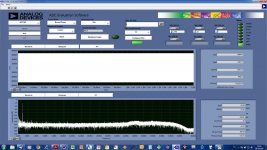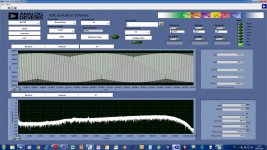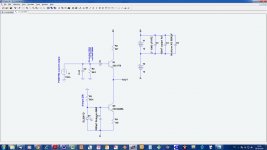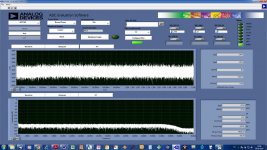bck comes from i2s device into the new 74vhc04 chip and out pin 5 which is connected to the mainboard i2s input headerMagic, ta.
So vcc, lrck and bck are joined onto, but not interrupted and data goes from the output of the existing chips, through these 2 new ones and on to the DAC decks. Seems straightforward enough
..
1. 6.04K resistor
2. JFET
3. Cascoded JFET
4. LM334 with tempco
5. JFET with 22uf cap across the source resistor
Carlsor, can you let us know how you build the JFET options? What JFET's, value resistors and pots did you use?
I'd like to give these a try.
Yep! the current firmware release is available here (right above the "DSD thing-ie") On windows you have to revert it do "factory defaults" with dfucons.exe (available in WaveIO's installation directory) and then use the USB Audio Device Firmware Upgrade to upload whatever .bin file you want from those two!..
...
BTW, to all who's asking where is the new *test* firmware used by Ian when we both tried to solve the problem: it is located here.
I expect this new firmware would add some stability to the I2S ports... but I didn't fully tried so I don't know how it will act on other areas. It also bring support for DoP and Native DSD playback but the LEDs are not working with these new features (that's why is a beta BTW)
There's a new firmware (BETA) for the Wave IO board, I thought some of you might like to know. I've not tested DSD playback yet..
CCS circuits values
stijn001,
CCS circuits: 2SK170 source resistor in all CCS circuits is 470 fixed plus 500 pot. This should work for 2SK170 with an Idss of 6-10ma.
Cascoded JFET circuit is shown in post 2622 on Aug 28. 22uf not needed. 825 replaced by 470 + 500pot. LED resistor can be from 1.5K to 4.7K from 8V. Gate resistors can be other values for testing. A lot of flexibility with the pot adjustment taking you to the promised land of 0.4ma from pin 20.
So far the single JFET CCS circuit sounds more musical to me. Dirt simple to make, but tricky finding a way to put it in the DDDAC.
Ross
stijn001,
CCS circuits: 2SK170 source resistor in all CCS circuits is 470 fixed plus 500 pot. This should work for 2SK170 with an Idss of 6-10ma.
Cascoded JFET circuit is shown in post 2622 on Aug 28. 22uf not needed. 825 replaced by 470 + 500pot. LED resistor can be from 1.5K to 4.7K from 8V. Gate resistors can be other values for testing. A lot of flexibility with the pot adjustment taking you to the promised land of 0.4ma from pin 20.
So far the single JFET CCS circuit sounds more musical to me. Dirt simple to make, but tricky finding a way to put it in the DDDAC.
Ross
Which is the hard part?So far the single JFET CCS circuit sounds more musical to me. Dirt simple to make, but tricky finding a way to put it in the DDDAC.
Ross
Once you've dialed in the current with the pot, can't you can measure and substitute for a fixed resistor value, then if you need an 8v supply, there's one very nearby, at least for the guys running shunt regs where the advice is to remove the electrolytics around the DAC chip.
This is a crappy photo from when I first tried a current diode, but it shows proximity to the available +8v originally for the 47uf cap
An externally hosted image should be here but it was not working when we last tested it.
Or am I missing something?
..
CCS circuits: 2SK170 source resistor in all CCS circuits is 470 fixed plus 500 pot. This should work for 2SK170 with an Idss of 6-10ma.
..
Ross, like this for a single JFET, right?

A DDDAC with DC coupled semi-passive output stage.
Hi All,
I've now mostly completed my DDDAC inspired D/A converter, however, I've used a different and capacitor-less output stage that I'm thinking might be interesting to someone here - the schematic is shown in one of the attachments to this post.
Since it's a rather straightforward circuitry I suppose someone else could have suggested this - I just haven't seen it which is why I now post it.
The circuitry basically is a passive I/V resistor which combined with the Vbe of a 2SC1775 transistor and the 6 kohm Doede has suggested for the Iref resistor makes for a DC offset of 0V +/- a couple of mVs. The DC offset is quite stable when the circuitry has warmed up and stabilized. In practice it is less than 10 mVs after a few minutes of warm up.
The output is somewhat lowish, app. 0.3 Vpp, however to my ears the sound is superb and all the harmonics at a 1kHz sine wave output are <= - 110 dBs relative to a 0 dB output level (shown in attachment; due to the 0.3 Vpp output level 0 dB data level output corresponds to -20.2 dBs with the ADC; for reference the noise level of the ADC with inputs shorted is also shown; measurements were made in the open with the DAC mounted on a wooden board - no shielding except of the ADC itself).
One caveat with this design is that the I/V resistor and the used transistors' Vbe needs be carefully adjusted to each other to obtain 0 VDC on the output. Yet by pairing the transistors and parallelling a couple of resistors this now works fine. After listening to a range of resistors (Shinkoh tantalum, Holco H4, Caddock TF, Vishay S102, PRP, Dale CMF, Welwyn RC-65, Xicon, RSX - see below, Takman REX & REY, carbon composition) I ended up using Dale's CMF60 resistor series, which is an ROHS compliant part, in parallel with an RSX resistor (I have a vague recollection that Doede uses the RN60 or RN65?). The RSX resistor comes from the hearing aid industry - very small, no more available yet very extended at the upper frequencies. Some of the other resistors - to my ears - were also fine but just different. The CMF60 + RSX resistor were just the most homogenous & without obvious flaws in this context.
I also tried various transistors (2SC2240, 2SC1775, 2SC3114, 2SD786, 2SC1845, 2SC2362, 2SD756, 2N3906) but ended up with the 2SC1775 run at a quite high quiescent current of 8 mA ... This actually happened by coincidence. I just happened to place the 2SC1775 in my circuitry with the CCS at a high current, yet found that (again to my ears) it sounded most open, very dynamic and upwards extended.
Since the 2SC1775 is a 50 mA max Ic transistor I normally wouldn't expect this to be so but looking at the transistor's datasheet both the Ft and Hfe are actually highest and most linear just around 8 mAs. Maybe this is part of the explanation ....? Measuring the distortions generated with some of the various transistors placed in the circuitry the 2SC1775 actually also had the lowest distortion figures closely followed by the 2SC2240 (I used wavegene to generate output wave forms).
I've also experimented with connecting a capacitor from the PCM1794's output (an optional capacitor in Doede's DDDAC paper) to ground. Values have been 4.7 nF, 10 nF, 22 nF, 100 nF (wima FKP2 4.7 nF, 10 nF, 22 nF; Russian Silver Mica 10 nF; Panasonic copper foil 100 nF). And although I do notice various degrees of "upwards calmness" with the different capacitors somehow it sounds to me as if the sound also becomes less dynamic and free/open - so for now I don't use any. Might eventually do so, though, but would then see if I can find a 2.2 - 3.3 nF panasonic copper foil polypropylene capacitor ...
And so - how about the sound? Well - to my ears - the most extended, nuanced, tonally integrated, speedy, spatially exceptionally transparent, layering, and altogether quick/"being there" DAC I've heard. Very, very musical yet also revealing of the recordings used. Just a very slight tad on the tonally light side - something I chose more or less deliberately by using Nichicon's KG capacitors in the PSU for the DAC's VDD and VCC and the 2SC1775 (the 2SC2240 in this circuitry sounds more "solid" if I can say it so).
Besides this output stage the rest of the DAC is composed of a combo384 with Acko reclocker & two NZ2520SD oscillators (45 & 49 MHz). Dual mono design, and in a couple of days I hope to be ready to attach batteries to the various voltages.
For those interested I will later today post some measurements of this DDDAC variant with sampling frequencies from 44.1 - 384 kHz in a new thread. I'll post a link when I've done so.
And then, last but certainly not least, thanks to Doede for having made this possible including publishing his various documents on how he made his DAC
Cheers
Jesper
Hi All,
I've now mostly completed my DDDAC inspired D/A converter, however, I've used a different and capacitor-less output stage that I'm thinking might be interesting to someone here - the schematic is shown in one of the attachments to this post.
Since it's a rather straightforward circuitry I suppose someone else could have suggested this - I just haven't seen it which is why I now post it.
The circuitry basically is a passive I/V resistor which combined with the Vbe of a 2SC1775 transistor and the 6 kohm Doede has suggested for the Iref resistor makes for a DC offset of 0V +/- a couple of mVs. The DC offset is quite stable when the circuitry has warmed up and stabilized. In practice it is less than 10 mVs after a few minutes of warm up.
The output is somewhat lowish, app. 0.3 Vpp, however to my ears the sound is superb and all the harmonics at a 1kHz sine wave output are <= - 110 dBs relative to a 0 dB output level (shown in attachment; due to the 0.3 Vpp output level 0 dB data level output corresponds to -20.2 dBs with the ADC; for reference the noise level of the ADC with inputs shorted is also shown; measurements were made in the open with the DAC mounted on a wooden board - no shielding except of the ADC itself).
One caveat with this design is that the I/V resistor and the used transistors' Vbe needs be carefully adjusted to each other to obtain 0 VDC on the output. Yet by pairing the transistors and parallelling a couple of resistors this now works fine. After listening to a range of resistors (Shinkoh tantalum, Holco H4, Caddock TF, Vishay S102, PRP, Dale CMF, Welwyn RC-65, Xicon, RSX - see below, Takman REX & REY, carbon composition) I ended up using Dale's CMF60 resistor series, which is an ROHS compliant part, in parallel with an RSX resistor (I have a vague recollection that Doede uses the RN60 or RN65?). The RSX resistor comes from the hearing aid industry - very small, no more available yet very extended at the upper frequencies. Some of the other resistors - to my ears - were also fine but just different. The CMF60 + RSX resistor were just the most homogenous & without obvious flaws in this context.
I also tried various transistors (2SC2240, 2SC1775, 2SC3114, 2SD786, 2SC1845, 2SC2362, 2SD756, 2N3906) but ended up with the 2SC1775 run at a quite high quiescent current of 8 mA ... This actually happened by coincidence. I just happened to place the 2SC1775 in my circuitry with the CCS at a high current, yet found that (again to my ears) it sounded most open, very dynamic and upwards extended.
Since the 2SC1775 is a 50 mA max Ic transistor I normally wouldn't expect this to be so but looking at the transistor's datasheet both the Ft and Hfe are actually highest and most linear just around 8 mAs. Maybe this is part of the explanation ....? Measuring the distortions generated with some of the various transistors placed in the circuitry the 2SC1775 actually also had the lowest distortion figures closely followed by the 2SC2240 (I used wavegene to generate output wave forms).
I've also experimented with connecting a capacitor from the PCM1794's output (an optional capacitor in Doede's DDDAC paper) to ground. Values have been 4.7 nF, 10 nF, 22 nF, 100 nF (wima FKP2 4.7 nF, 10 nF, 22 nF; Russian Silver Mica 10 nF; Panasonic copper foil 100 nF). And although I do notice various degrees of "upwards calmness" with the different capacitors somehow it sounds to me as if the sound also becomes less dynamic and free/open - so for now I don't use any. Might eventually do so, though, but would then see if I can find a 2.2 - 3.3 nF panasonic copper foil polypropylene capacitor ...
And so - how about the sound? Well - to my ears - the most extended, nuanced, tonally integrated, speedy, spatially exceptionally transparent, layering, and altogether quick/"being there" DAC I've heard. Very, very musical yet also revealing of the recordings used. Just a very slight tad on the tonally light side - something I chose more or less deliberately by using Nichicon's KG capacitors in the PSU for the DAC's VDD and VCC and the 2SC1775 (the 2SC2240 in this circuitry sounds more "solid" if I can say it so).
Besides this output stage the rest of the DAC is composed of a combo384 with Acko reclocker & two NZ2520SD oscillators (45 & 49 MHz). Dual mono design, and in a couple of days I hope to be ready to attach batteries to the various voltages.
For those interested I will later today post some measurements of this DDDAC variant with sampling frequencies from 44.1 - 384 kHz in a new thread. I'll post a link when I've done so.
And then, last but certainly not least, thanks to Doede for having made this possible including publishing his various documents on how he made his DAC
Cheers
Jesper
Attachments
Last edited:
The link to measurements on this DAC is:
http://www.diyaudio.com/forums/digi...384-khz-sampling-frequencies.html#post4061955
Jesper
http://www.diyaudio.com/forums/digi...384-khz-sampling-frequencies.html#post4061955
Jesper
A P.S.: The ferrite bead in the schematic is mounted directly on the transistor leg. It's one of those 5 mm long, 1.5 mm inner diameter cylinder beads that a wire can go through. In my experience using the bead sort of "assembles" the sound without any obvious side-effects.
Regards,
Jesper
Regards,
Jesper
Ross, like this for a single JFET, right?
An externally hosted image should be here but it was not working when we last tested it.
stijn001,
You don't need to get a 2SK170 to build this; not that it wouldn't work (Ross got some good results out of this), but to know your options, take a look at this paper: http://www.vishay.com/docs/70596/70596.pdf. I don't recall if you were part of this conversation when these points were made...
Also, see post #2798 for a more extensive review of using JFETs.
Radu.
stijn001,
Schematic is exactly right. Physically mount the 470 ohm resistor where you can measure the voltage across it. For me, 0.191 volts translates to 0.406ma which gives me the same Rload voltage as a 6.04K resistor.
dwjames,
Well yeah it's easy if you remove that 47uf cap. I use an external 8V Salas shunt supply which benefits from a destination electrolytic cap.
Schematic is exactly right. Physically mount the 470 ohm resistor where you can measure the voltage across it. For me, 0.191 volts translates to 0.406ma which gives me the same Rload voltage as a 6.04K resistor.
dwjames,
Well yeah it's easy if you remove that 47uf cap. I use an external 8V Salas shunt supply which benefits from a destination electrolytic cap.
stijn001,
You don't need to get a 2SK170 to build this; not that it wouldn't work (Ross got some good results out of this), but to know your options, take a look at this paper: http://www.vishay.com/docs/70596/70596.pdf. I don't recall if you were part of this conversation when these points were made...
Also, see post #2798 for a more extensive review of using JFETs.
Radu.
Thanks I have a few 2SK170's to test with, If I remember correctly we'd deducted that the J201 made a good and available option too.
Yes, and sorry for not recalling you participated.
It's very much worth mentioning again - Ross was the first to post this here - Linear Systems has the LSK170 as a replacement ("improved") for Toshiba's 2SK170. I contacted them to inquire on availability and ordering information. Not unobtainium, maybe.
(I have some 2SK170s acquired years back, but I am interested in getting more of these for some Borbely/Salas based phono stage work and need them... but I digress)
Radu.
It's very much worth mentioning again - Ross was the first to post this here - Linear Systems has the LSK170 as a replacement ("improved") for Toshiba's 2SK170. I contacted them to inquire on availability and ordering information. Not unobtainium, maybe.
(I have some 2SK170s acquired years back, but I am interested in getting more of these for some Borbely/Salas based phono stage work and need them... but I digress)
Radu.
Good to know, thanks.
Geez...! Has been sometime since. Sound very doggy!Nope, as soon as I ordered/paid for it, they sent a backorder notice.
Actually, I found without isolator and using the Pi with proper linear ps or Shunt, and also USB wifi dongle on USB extension yield excellent result. Avoid Ethernet as it introduces noise. I also use Doede ps as ps for my HDD docking and Rune 0.3-alpha as OS. This combo works super for me. Lastly, I found custom made i2s cable from neotech core Cu or cat 5 with max 5cm in length between DAC and Pi sounds yet better again.
Best to have a reclocker tooGeez...! Has been sometime since. Sound very doggy!
Actually, I found without isolator and using the Pi with proper linear ps or Shunt, and also USB wifi dongle on USB extension yield excellent result. Avoid Ethernet as it introduces noise. I also use Doede ps as ps for my HDD docking and Rune 0.3-alpha as OS. This combo works super for me. Lastly, I found custom made i2s cable from neotech core Cu or cat 5 with max 5cm in length between DAC and Pi sounds yet better again.so many variables.

Pi i2s isn't fantastic
- Home
- Source & Line
- Digital Line Level
- A NOS 192/24 DAC with the PCM1794 (and WaveIO USB input)



